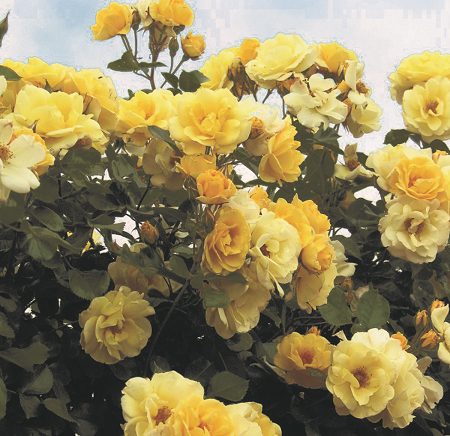
For most rosarians, those of us who live in climates where winters are cold, April is the beginning of the rose season. It’s the time we remove our winter protection materials, prune, plant the new roses we’ve no doubt bought, and begin our fertilizing and spray regimens for the season. It’s the busiest time, but the one that promises to yield the healthiest plants and the most flowers throughout the growing season.
Most novice rosarians tend to want to wait until all danger of frost has passed before they do anything in the garden. While that may be the best case for annuals, roses need an earlier start. The soil warms long before we think it does, and the feeder roots, which were killed by winter’s cold and are vital to keeping the plants alive, strong, and healthy, begin re-growing even before pruning time.
So, too, do the new roses you’ll be planting this spring. Bareroot plants that you received by mail-order have no feeder roots, and the potted plants you buy at the garden center at optimum planting time—April—have just started growing their vital feeder roots. The biggest mistake novice rosarians make is waiting to see the plants blooming before they buy their potted roses at their garden centers. By this time, the plants will be harder to transplant, and you’ll lose several weeks of flowers when you prune the canes back to prevent transplant shock.
Your best bet is always to select your new roses from the rose catalogs or from the mail-order websites based on the photos and descriptions and wait to see the actual blooms in your own garden. If you buy potted plants at your local garden center, they’ll be available at the correct planting time in your area—now—but they won’t be blooming. So, use the picture tags to select the varieties you can’t live without.
Cold climate rosarians can always expect to see some winter damage on your plants, but if you protected them properly in the fall, the parts of the plants under the soil mounds should be green and healthy. Prune off all the dead parts of the canes, right back to nice green wood. And don’t be nervous about cutting the canes really, short. The green canes will sprout lots of new leaves and stems, and your plants will be even bigger and better than they were last season.
Established plants should be fertilized right away with a good evenly balanced fertilizer formulated specifically for roses. An 8-8-8 formula works well now and once buds have set, switch to an 8-20-1 for the remainder of the season. This formula encourages the plants to produce big flowers on sturdy stems.
New roses purchased from a mail-order source will arrive bareroot and should be unpacked immediately and their roots submerged in a bucket of water until your ready to plant. Many mail-order suppliers tend to send the dormant plants a little before the best planting time, so keep the buckets in the garage and out of sunlight until the forsythia blooms. Potted roses from your garden center and packaged roses, which are often found at home improvement stores, are not available until the correct planting time in your area. The packaged roses are usually planted in a small fiber pot and, should be removed from their boxes and plastic bags, and the soil watered immediately and kept moist until you’re ready to plant. If they’ve already started to sprout, keep them outside in a shady place, gradually moving them into full sun, so as not to burn the tender white shoots.
Roses potted in large pots and purchased at your local garden center are ready to plant. These roses have been living outside, so keep them outside and their soil moist until you’re ready to put them in the ground.
Newly planted roses should not be fertilized for a month, as you don’t want to risk burning the delicate feeder roots which are growing rapidly beneath the soil. But all the roses, new and established, should be sprayed with a good fungicide, miticide, and insecticide to prevent (guess what) rose diseases, mites, and bugs from attacking all that tender new foliage. Thoroughly spray all the above-ground parts of the plants. If you have only a few roses, try Bayer 3 in 1 Concentrate. If you have more than a dozen or so roses, you might want to look for more cost-effective materials. Spray regularly throughout the season, and you’re unlikely to be plagued by any rose problems at all!
Ann Hooper is a certified American Rose Society Consulting Rosarian.
Related Articles & Free Email Newsletter Sign Up
3 Ways to Figure Out the Correcting Plant Time for Roses
Struggling with Roses? Read the Directions and Try Again




Comment here